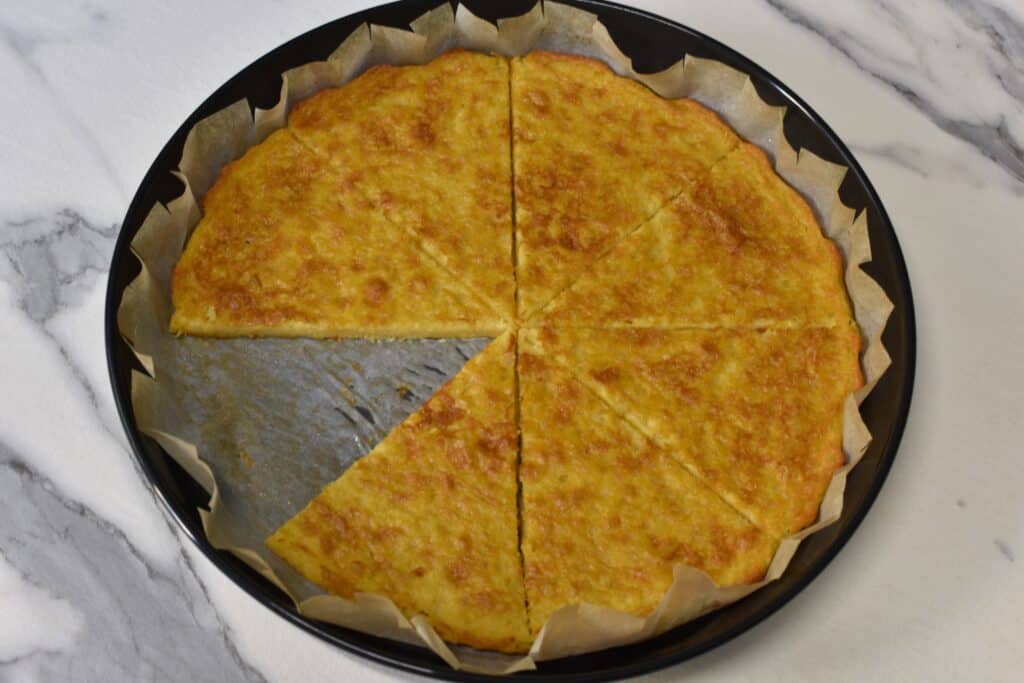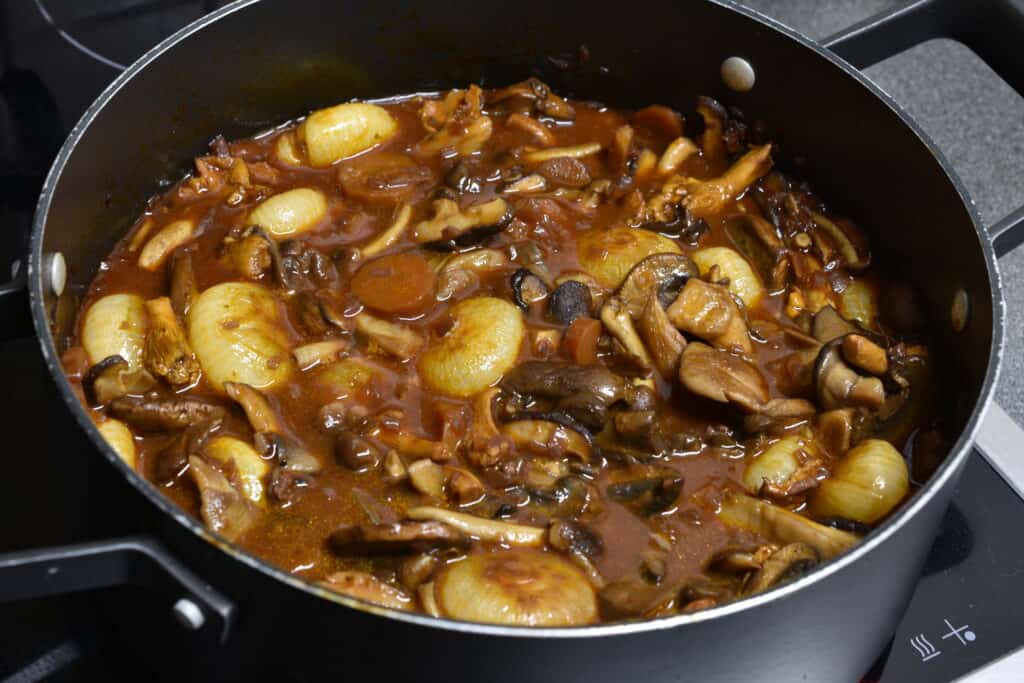Farinata di ceci (chickpea farinata) is a delicious, thin, speciality flatbread originating from the region of Liguria in Italy. Farinata is made of a very simple emulsion of chickpea (gram) flour, water, oil and salt. The mixture is poured into a shallow pan and baked in a very hot oven, which gives the farinata its distinctive crispy golden top and edges. Typically, it’s baked in a “forno a legna” (wood-fired oven – the same kind pizzas are made in). Here, you’ll find all the tips and tricks to make perfect farinata in your own oven at home!
Tradition has it that Ligurian farinata must be thin – strictly less than 1 cm thick – usually between 0,4 and 0,8 cm when cooked. You can find slices of farinata in almost every “panetteria” (baker’s) and “gastronomia” (delicatessen), as well as all sorts of takeaways and lunch joints throughout the region. There are even “farinaterie” – places that make just farinata (in the same way that pizzerie are home to pizza!)
Farinata has recently reached culinary recognition and worldwide fame thanks to the Internet and International chefs. As a result, it’s become one of Italy’s best-loved street foods, even beyond the borders of Liguria, sharing a similar status to that of focaccia, pizza and pinsa.

Origins of farinata
Originally a poor man’s dish, farinata dates back hundreds of years to medieval times. It was “imported” by the Maritime Republics of Genoa and Pisa, thanks to their trade connections with the Arab world. In Liguria, it took the name fainâ. In Pisa, cecìna. It’s also made in Sardegna, where it’s known as fainè, and is often baked with other ingredients, such as onions and black pepper. In other Italian regions, it goes by different names. Torta di ceci, padellata di ceci, calda calda and belacauda are some of its aliases. In Nice and the Côte d’Azur, they call it socca. Around Toulon and Marseille, you’ll find it under the name cade. It’s also massively popular in Uruguay and Argentina, where they call it fainá. Read more about farinata on Wikipedia.

How to make chickpea farinata
This farinata recipe is true to the original, tried and tested multiple times to deliver perfect results at home in a normal domestic oven. Traditional Ligurian chickpea farinata – smooth and creamy on the inside and golden and crispy on the outside. Healthy “fast food” that’s tasty, satisfying, and exactly like the farinata you’ll find in Liguria! Trust me, I know – I go there at least once every summer. It’s only a two-hour drive from where I live, and I love to go there for a long weekend whenever I get the chance! If you’re curious, this is what an authentic Ligurian farinata from Genoa looks like!
Hands-on time is absolutely minimal. It takes a minute to mix the chickpea flour and water. Afterwards, you leave it to stand for several hours (while you go to work or do other things). When you’re ready to make your farinata, you add the oil and salt and mix it again. This will take you another minute. After that, you pour the emulsion into a shallow pan and bake it in a hot oven for a total of 27 minutes. In the meantime, you can be preparing the rest of your meal or doing other things. It’s one of the quickest and easiest meals you’ll ever make!

Farinata made with red lentil flour or green pea flour
Farinata can also be made with red lentil flour or green pea flour. Both are delectable alternatives to the traditional recipe with chickpea flour. The quantities and method are identical – you simply substitute the chickpea flour with the same amount of red lentil or green pea flour and proceed as explained in the recipe card below.
Below you’ll see a photo of a green pea farinata with a light topping of leek and garden peas that I made as an experiment. It was delicious, especially the leek! The green peas are only a garnish, though – the farinata is made with green pea FLOUR.


Important tips and method
- First of all, you don’t need a special farinata pan to make this recipe! You can use a standard metal tart tin.
- Use the right-sized tin. The quantities in this recipe are for a 28 – 30 cm diameter tin. If your tin is a different size, see the note at the foot of the recipe card – you’ll find a link to a website that calculates everything for you, automatically reducing or increasing the quantities proportionally to the size of the tin you’ll be using.
- Put the chickpea flour and water in a bowl. Amalgamate well with a hand whisk or wooden spoon until smooth (don’t use an electric whisk). Cover and leave to stand for at least 3 hours at room temperature. This allows the chickpea particles to rehydrate fully. If the ambient temperature is above 22°C, it’s best to refrigerate it.
- It isn’t necessary to remove the foam from the surface of the batter – the bubbles go away on their own. If you remove the foam, you’ll also be reducing the water content in the mixture and wasting some of the batter.
- Line the tin with a sheet of baking parchment. See the detailed instructions in the recipe card below.
- Grease the baking parchment with a little oil. This will ensure the farinata doesn’t stick. That way, it will be golden and crispy underneath as well as on top.

- Preheat your oven to the highest possible temperature.
- Add the oil and salt to the chickpea batter and mix well. When everything is ready, give the mixture a final stir. The oil must be well-amalgamated with the chickpea flour and water.
- Working quickly, pour the mixture onto the greased baking parchment. Be careful not to tilt the tin. Otherwise, the liquid might seep through the slits in the paper and onto the tin underneath.
- Bake for 12 minutes at the highest possible temperature on the lowest shelf of the oven (make sure the heat from the bottom of the oven is on high!) Use an oven rack, not a solid tray.
- After 12 minutes, turn the heat down to 200 °C and move the farinata up to the 2nd shelf. Once again, use a rack. Bake for another 15 minutes at 200 °C.
- Remove the farinata from the oven and leave it to stand for 5 minutes before cutting it. It will peel off the baking parchment easily.

- I have an electric, fan-assisted oven. If you have a different kind of oven, you may need to tweak the times and temperatures a bit if you get different results to mine the first time.
How to serve farinata
Farinata is definitely best when freshly made and still hot. Allowing it to stand for 5 minutes gives the centre time to set properly before you cut it. It can also be eaten cold. Both locals and tourists in Liguria buy slices of it at the baker’s and other food outlets and eat it while walking along the street or sunbathing on the beach.
Seasoning is very simple – usually just the salt in the mixture. Farinata is traditionally plain, and that’s how I like mine too. Sometimes I grind a little black pepper over the surface of the mixture just before it goes in the oven.
I have seen some toppings on farinata, although not in Liguria. In Como, I’ve seen it with thinly sliced carrots and courgettes on top. Although it’s nice and tasty, it’s thicker and has none of the traditional crispiness of authentic Ligurian farinata. Rosemary is another popular choice, for example. I’ve done a fair amount of experimenting myself, and below you’ll find a list of toppings that are very nice. But at the end of the day, it’s not “the real farinata” like they make in Liguria. It’s like putting tons of ingredients on pizza… It may be nice, but the Italians just don’t do it that way!

Toppings
Unless otherwise stated, the toppings go on before you put the farinata in the oven.
The toppings must be a very thin layer – otherwise, the farinata won’t cook properly. Avoid anything that would release additional water during baking because it will make your farinata wet on top, and it won’t be golden and crispy. Don’t add salt to the toppings because it makes the vegetables release water due to the process of osmosis. Only put salt in the mixture (see recipe card below) and on the toppings after the farinata comes out of the oven.
- Freshly ground black pepper
- Saffron (put into the mixture along with the oil and salt)
- Oregano
- Thyme
- Fresh or dried rosemary
- Very thin slices of red onion (also yellow and white onion)
- Very thin slices of courgette (and a light sprinkling of sea salt AFTER it comes out of the oven)
- Very thin slices of courgette, carrot and onion (and a light sprinkling of sea salt AFTER it comes out of the oven)
- Very thin slices of tomato and oregano. This is not the best option because of the high water content in the tomatoes. If you really want to give it a try, use a tomato like the Italian plum variety, which has less juice.
My recommendation is to stick to a simple flavouring and not be tempted to start adding lots of different ones. Farinata is a simple dish where the delicate chickpea flavour is the star of the show. Keep your farinata plain, or use ONE of the above flavourings/toppings.
What to serve with farinata
I much prefer to serve something with farinata rather than putting a topping on it. Think of farinata as a fancy kind of flatbread, and you’ll come up with loads of ideas! Salads, vegetable dishes and soups are all good accompaniments to farinata. Raw vegetable sticks and dips are another great choice. I love serving farinata as a warm buffet food, along with vegan quiche, focaccia etc.
How to keep leftover farinata
Farinata is definitely best eaten minutes after it has come out of the oven. If you have any leftovers, store them in an air-tight container in the refrigerator, where they’ll keep for a couple of days. In the freezer, they’ll keep for a couple of months. You can reheat farinata in the oven or in the microwave.
I hope you enjoy this chickpea farinata recipe! If you do, it would be great if you could rate it and leave a comment below. Your feedback is valuable! It’s the best way to show your support, and it’s useful for other readers too.
You may also like these recipes:




Would you like to receive my recipes as soon as I publish them? Subscribe below!











Thanks for this receipe! This has become a regular dish when friends are visiting. I serve it with grilled vegatables, pestos of various kind and more. Always a hit!
Thanks for the great review, Annika! So glad you like my farinata!